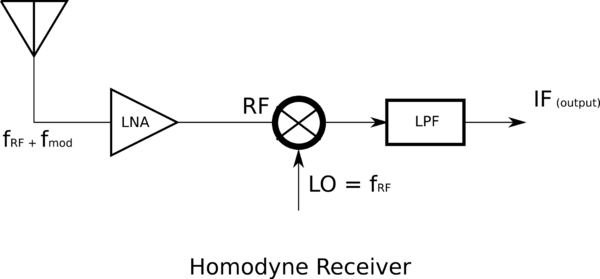Difference between revisions of "RF Communications"
(Created page with "== RF communications == Types of Modulation: Amplitude Modulation (AM), Single Side Band (SSB), Frequency Modulation (FM), Phase Modulation (PM)<br><br> Modulation T...") |
(→RF communications) |
||
| Line 23: | Line 23: | ||
If the IF on the receive side is above audible frequencies an additional mixer is | If the IF on the receive side is above audible frequencies an additional mixer is | ||
required to bring the IF down to audible frequencies (this is known as a superheterodyne | required to bring the IF down to audible frequencies (this is known as a superheterodyne | ||
| − | receiver - the "super" refers to "super audible").<br><br> | + | receiver - the "super" refers to "super audible"). |
| + | |||
| + | [[File:HomodyneReceiver.png|600px]] [[File:SuperHeterodyneReceiver.png|800px]]<br><br> | ||
| + | [[File:HeterodyneReceiver.png|600px|center]] | ||
| + | |||
| + | |||
| + | |||
3.0) Use two mixers and suitable fxn generators and filters to mod/demod audio frequency (AF ~ a few kHz) on an RF carrier. | 3.0) Use two mixers and suitable fxn generators and filters to mod/demod audio frequency (AF ~ a few kHz) on an RF carrier. | ||
Revision as of 12:17, 17 February 2022
RF communications
Types of Modulation: Amplitude Modulation (AM), Single Side Band (SSB), Frequency Modulation (FM),
Phase Modulation (PM)
Modulation Type: AM
1.0) Choose frequency/wavelength of interest.
2.0) Build and test two 1/2 wavelength dipole antennas (send and receive).
2.1) Input appropriate RF carrier frequency into transmitting antenna (sine wave of ~ 1Vpp).
2.2) Attach oscilloscope to reveiving antenna and observe transmitted RF carrier wave.
2.3) Attach RF carrier to LO port of mixer and another sine wave (~ few MHz at 1Vpp) to IF port
of mixer. Attach the mixer's RF port to the transmitting antenna (this is "upconversion").
2.4) Observe the modulated RF carrier with an oscilloscope attached to the receiving antenna.
2.5) Is the carrier frequency clearly present (use o-scope's FFT function to observe)?
Are the side bands clearly present and at the correct frequency offsets? Vary the
modulation frequency of the sine wave sent to the mixer's IF port. Do the RF
sidebands follow suite?
Types of receivers: Homodyne (or Direct Conversion), Heterodyne, Superheterodyne
If the LO input to the receive-side mixer is of the same frequency as the LO on the send side
you have a homodyne or direct-conversion receiver (if not, you have a heterodyne receiver).
If the IF on the receive side is above audible frequencies an additional mixer is
required to bring the IF down to audible frequencies (this is known as a superheterodyne
receiver - the "super" refers to "super audible").
3.0) Use two mixers and suitable fxn generators and filters to mod/demod audio frequency (AF ~ a few kHz) on an RF carrier.
Use one mixer on the receiving side to build a homodyne receiver (this is called "downconversion").
3.1) Observe AF on the o-scope.
3.2) Send and receive various audio tones (use a speaker and amplifier on the receive side to
hear the AF tones).
3.3) Attach microphone and amplifier to IF port of transmitting system.
3.4) Send and receive voice.
3.5) Build a heterodyne receiver.
3.6) Build a superheterodyne receiver. Repeat steps 3.1-3.4
4.0) Using the superheterodyne receiver, build an RF pre-selection bandpass (BP) filter between the antenna and the mixer on the receive side
(centered on the RF carrier with appropriate bandwidth).
4.1) Build preamp between the pre-selection filter and the receive mixer (gain ~ 100).
4.2) Build an IF filter then a low noise amplifier (LNA) between the first mixer's IF port and the second mixer.
4.3) Build an AF filter and power amp between the second mixer and the speaker.
(choose bandwidth wisely ~ 300-3kHz)
- FM mod/demod - Build transmit/receive circuits
- Direct Conversion I/Q Software Defined Radio (SDR) - DAQ/Labview interface
- Digital modes???* FM mod/demod - Build transmit/receive circuits
- Digital modes???* FM mod/demod - Build transmit/receive circuits
Equipment: wire for antennas, wood for support, BNC connectors, solder, mixers (at least double balanced), fxn gens and filters, speaker, amplifier


